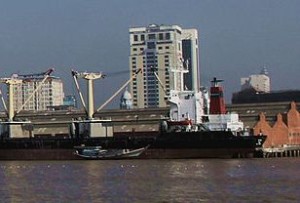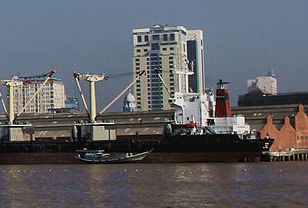 While global container trade is in slowdown mode, intra-Asia commerce is buoyant in contrast. But Clarkson says this is in large part fueled by fast-rising China-Southeast Asia commerce, as shown by the growing number of Chinese carriers being deployed on the lane.
While global container trade is in slowdown mode, intra-Asia commerce is buoyant in contrast. But Clarkson says this is in large part fueled by fast-rising China-Southeast Asia commerce, as shown by the growing number of Chinese carriers being deployed on the lane.
This year, Chinese capacity deployed on Far East-Southeast Asia routes has risen significantly. In fact “the rapid growth in deployment by Chinese liners this year is almost entirely due to a 55% increase in vessel capacity deployed on Far East-Southeast Asia routes,” said the report.
It attributes this growth to increasing trade between China and Southeast Asian countries. Following the introduction of the China-ASEAN Free Trade Agreement in 2010, China’s exports to the Association of Southeast Asian Nations grew on average by 14% per annum in 2011-2014, while annual imports from the region grew by 9% in the same period.
Chinese liners have also been expanding their Far East-Southeast Asia services following the introduction of the government’s “One Belt, One Road” strategy at the end of last year.
For example, China Shipping Container Lines has improved its ASEAN service coverage by calling at more ports in Vietnam and Thailand, and launching direct services from China to Indonesia and Myanmar. Meanwhile Minsheng Shipping, which usually focuses on the domestic market, has cooperated with foreign partners to launch Southeast Asian services this year.
Data show trade volumes between China and ASEAN are continuing their strong growth momentum, as the value of Chinese exports to ASEAN rose by 9.5% year-over-year in the first half of 2015, compared with 1% growth in total Chinese exports.
However, the relatively low overall trade volumes and port limitations mean that small container ships still dominate deployment on these routes. Most vessels deployed on Far East-Southeast Asia routes are below 3,000 twenty-foot equivalent units or TEUs, with an average size of 1,700 TEUs compared to an average size of 3,500 TEUs on coastal Chinese routes.
“The continuation of firm trade growth between China and ASEAN, even while China’s trade with some other regions has come under pressure this year, suggests that this remains a key driver of intra-Asian (and global) box trade growth. Far East-SE Asia routes in particular therefore may well offer further significant opportunities for Chinese operators,” said the report.
Meanwhile, Clarkson provided more general data on intra-Asia container trade, noting its rapid growth in the last five years by an estimated average of 10% per annum to reach 48 million TEUs in 2014, representing more than 25% of global container trade.
Around 60% of intra-Asia trade involves China, and Chinese operators play a major role in the provision of intra-Asian liner services. Total container ship capacity deployed on intra-Asian routes reached 1.7 million TEUs at the start of July 2015, up from 1.1 million TEUs at the start of 2011. Vessel capacity deployed on intra-Asia trades by Chinese liners has also increased quickly, to total 400,000 TEUs at the end of the first half of 2015, more than double the total at start 2011.
Together, the capacity currently deployed by Chinese operators accounts for 24% of total intra-Asian deployed capacity. Growth has been very firm this year, with Chinese operated box ship capacity rising 13% in first half of 2015. Chinese liners operate services on a variety of intra-Asia routes, with 40% of capacity operated on coastal Chinese trades, with another 34% on Far East-Southeast Asia services and 21% on China-Japan-South Korea routes.
Photo: Thettin684





